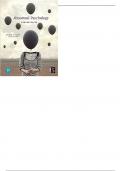Class notes
Intro to psychology Part 1: Psychological Therapies
- Institution
- University Of Cape Town (UCT)
This is a summary of a lecture series that covered the various types of psychological therapies namely, Psychoanalytic Therapies, client-centered therapies, behavioural therapies and cognitive therapies.
[Show more]




